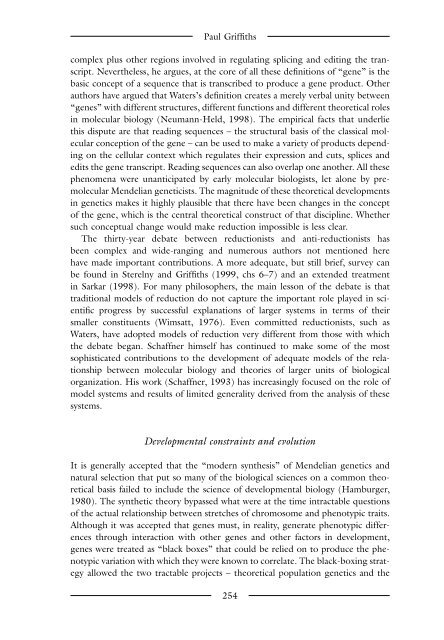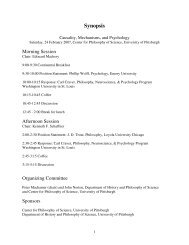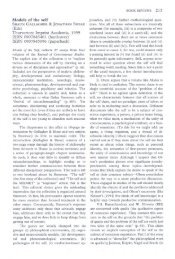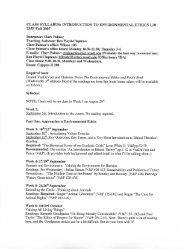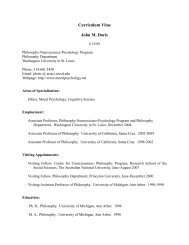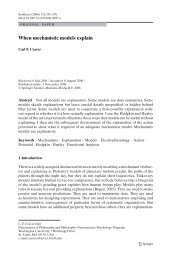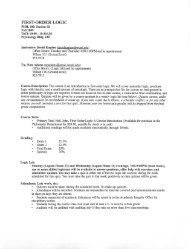The Blackwell Guide to the Philosophy of Science - The Department ...
The Blackwell Guide to the Philosophy of Science - The Department ...
The Blackwell Guide to the Philosophy of Science - The Department ...
Create successful ePaper yourself
Turn your PDF publications into a flip-book with our unique Google optimized e-Paper software.
Paul Griffiths<br />
complex plus o<strong>the</strong>r regions involved in regulating splicing and editing <strong>the</strong> transcript.<br />
Never<strong>the</strong>less, he argues, at <strong>the</strong> core <strong>of</strong> all <strong>the</strong>se definitions <strong>of</strong> “gene” is <strong>the</strong><br />
basic concept <strong>of</strong> a sequence that is transcribed <strong>to</strong> produce a gene product. O<strong>the</strong>r<br />
authors have argued that Waters’s definition creates a merely verbal unity between<br />
“genes” with different structures, different functions and different <strong>the</strong>oretical roles<br />
in molecular biology (Neumann-Held, 1998). <strong>The</strong> empirical facts that underlie<br />
this dispute are that reading sequences – <strong>the</strong> structural basis <strong>of</strong> <strong>the</strong> classical molecular<br />
conception <strong>of</strong> <strong>the</strong> gene – can be used <strong>to</strong> make a variety <strong>of</strong> products depending<br />
on <strong>the</strong> cellular context which regulates <strong>the</strong>ir expression and cuts, splices and<br />
edits <strong>the</strong> gene transcript. Reading sequences can also overlap one ano<strong>the</strong>r. All <strong>the</strong>se<br />
phenomena were unanticipated by early molecular biologists, let alone by premolecular<br />
Mendelian geneticists. <strong>The</strong> magnitude <strong>of</strong> <strong>the</strong>se <strong>the</strong>oretical developments<br />
in genetics makes it highly plausible that <strong>the</strong>re have been changes in <strong>the</strong> concept<br />
<strong>of</strong> <strong>the</strong> gene, which is <strong>the</strong> central <strong>the</strong>oretical construct <strong>of</strong> that discipline. Whe<strong>the</strong>r<br />
such conceptual change would make reduction impossible is less clear.<br />
<strong>The</strong> thirty-year debate between reductionists and anti-reductionists has<br />
been complex and wide-ranging and numerous authors not mentioned here<br />
have made important contributions. A more adequate, but still brief, survey can<br />
be found in Sterelny and Griffiths (1999, chs 6–7) and an extended treatment<br />
in Sarkar (1998). For many philosophers, <strong>the</strong> main lesson <strong>of</strong> <strong>the</strong> debate is that<br />
traditional models <strong>of</strong> reduction do not capture <strong>the</strong> important role played in scientific<br />
progress by successful explanations <strong>of</strong> larger systems in terms <strong>of</strong> <strong>the</strong>ir<br />
smaller constituents (Wimsatt, 1976). Even committed reductionists, such as<br />
Waters, have adopted models <strong>of</strong> reduction very different from those with which<br />
<strong>the</strong> debate began. Schaffner himself has continued <strong>to</strong> make some <strong>of</strong> <strong>the</strong> most<br />
sophisticated contributions <strong>to</strong> <strong>the</strong> development <strong>of</strong> adequate models <strong>of</strong> <strong>the</strong> relationship<br />
between molecular biology and <strong>the</strong>ories <strong>of</strong> larger units <strong>of</strong> biological<br />
organization. His work (Schaffner, 1993) has increasingly focused on <strong>the</strong> role <strong>of</strong><br />
model systems and results <strong>of</strong> limited generality derived from <strong>the</strong> analysis <strong>of</strong> <strong>the</strong>se<br />
systems.<br />
Developmental constraints and evolution<br />
It is generally accepted that <strong>the</strong> “modern syn<strong>the</strong>sis” <strong>of</strong> Mendelian genetics and<br />
natural selection that put so many <strong>of</strong> <strong>the</strong> biological sciences on a common <strong>the</strong>oretical<br />
basis failed <strong>to</strong> include <strong>the</strong> science <strong>of</strong> developmental biology (Hamburger,<br />
1980). <strong>The</strong> syn<strong>the</strong>tic <strong>the</strong>ory bypassed what were at <strong>the</strong> time intractable questions<br />
<strong>of</strong> <strong>the</strong> actual relationship between stretches <strong>of</strong> chromosome and phenotypic traits.<br />
Although it was accepted that genes must, in reality, generate phenotypic differences<br />
through interaction with o<strong>the</strong>r genes and o<strong>the</strong>r fac<strong>to</strong>rs in development,<br />
genes were treated as “black boxes” that could be relied on <strong>to</strong> produce <strong>the</strong> phenotypic<br />
variation with which <strong>the</strong>y were known <strong>to</strong> correlate. <strong>The</strong> black-boxing strategy<br />
allowed <strong>the</strong> two tractable projects – <strong>the</strong>oretical population genetics and <strong>the</strong><br />
254


